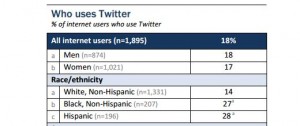Apparently Twitter has decided to form an all-white, all-male board as its first public act as a soon-to-be public company.
Really, we have to have this conversation again?
This isn’t about leaning in, or leaning out, or leaning sideways. It’s not about feminism, the glass ceiling, equal rights, or equal pay. This isn’t even really about diversity.
We don’t know what we don’t know.
I don’t want to suggest that men can’t market to women, or that white men don’t or can’t understand diversity. But the problem when you only talk to yourself is the unintended consequences of having no outside filter.
Here’s a recent snapshot of Twitter’s demographics, which shows that Hispanics and Blacks are using Twitter at twice the rate of White survey respondents. (Not to mention the 50 percent of users who are women.) And these statistics only cover U.S. users.

Your context is shaped by your experience.
Diversity is a squishy term. It’s why if you look at organizations that “do” diversity (as I did recently for a project) you’ll see that the definitions are all over the place. Is it about gender? Generations? Race? Religion?
Defining diversity is a bit like Justice Stewart’s famous definition of obscenity: I know it when I see it.
Let’s be clear: I have no idea what the “ideal” Twitter board looks like. Maybe they’re laser-focused on corporate ad revenue and this is the right board to achieve that goal. But corporate ad revenue is only as valuable as the eyeballs the ads reach—and that requires Twitter to continue to innovate with all its users in mind.
Smart companies value context and diversity. The trick is to define these wisely for your business.
Photo by shortformvideo (Flickr).



